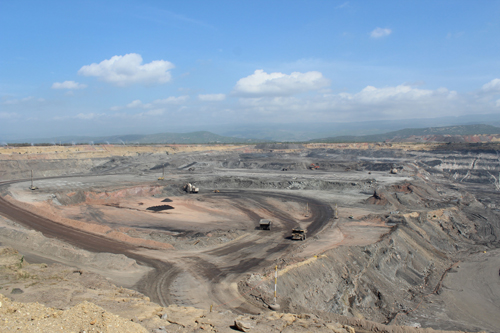
Deep in the North Eastern Colombian state of La Guajira lies one of the biggest open cast coalmines on earth. Cerrejon – taking its name from the indigenous Wayuu language term for “sacred mountain” – has been blasting coal out of the land since 1981. Owned by industry giants BHP Billiton, Glencore Xtrata, and Anglo-American (respectively the first, fourth, and sixth biggest mining corporations in the world), it’s a huge operation, extracting 33 million tonnes of coal each year. The periodic blasts of explosives make the area sound like a war zone. Freight-trains thunder along 150km of track up to Puerto Bolivar, where 60 per cent of the load is shipped to Europe, much of it to UK power stations. Spanning 170,000 acres and employing some 12,000 workers, la mina dominates the area, from the small mining town of Barrancas to the subsistence agricultural communities beside it.
Cerrejon's strapline is “Mineria Responsable" – “Responsible Mining”. But the good fortune of the three mining companies has come at a cost to locals. Indigenous people form 45 per cent of the population of La Guajira. Wayuu (Latin American) and Afro-Colombian communities have lived for centuries in the rocky, arid plains nearby. But according to Indepaz, an NGO working with displaced communities in the area, 17 of these communities have “disappeared” over the last 20 years.
This is closely tied to the expansion of the mine. The pits within the Cerrejon complex are named after the communities that they displaced; they include Roche, Chancleta, Tamaquitos, Manantial, Tabaco, Palmarito, El Descanso, Caracoli, Zarahita, and Patilla.
The violent eviction of the African-descent Tabaco community in 2001 made international headlines. They were violently evicted by the Colombian military on behalf of the mine, and 427 families are still scattered around the region. The government is not required by law to resettle them, so they remain a community displaced from each other and their territory. “We were displaced with fire and blood,” says Rogelio Ustate, a Tabaco leader. “330 police officers, a brigade of solders and bulldozers came to destroy our community. In the past 10 years we have taken 230 legal actions and only one was upheld. This was for the municipality of Hato Nuevo to reconstruct our community and build us houses. We have been waiting 13 years for this to happen.” Tabaco, like many communities in the area, was self-sufficient and deeply rooted to the land, bartering and living a pastoral, agricultural, low impact lifestyle. “We were producers. Now, disgracefully, we are consumers,” says Rogelio.
The destruction of Tabaco highlighted the plight of these communities. Realising the reputational risks for Cerrejon and the government, the mine’s owners switched tactics. Now, to secure expansion of the mine, they began to pay off communities, promising “productive projects”, new livelihoods, and opportunities.
The Patilla mine supervisor speaks earnestly as he gestures to a huge vista of open pits. Small fires break out as giant coal trucks crawl back and forth. “We're transforming the environment, not destroying it. We are doing this for the benefit of humanity,” he says. The mine's current project is to re-route a number of springs and the Rio Rancheria river in order to access 500 million tonnes of coal underneath. Cerrejon named the project “The Arrival of the Spring” in Wayuu. The issue of the river being re-routed 26km is a line in the sand for the communities.
Perhaps unexpectedly, the coal miners' union, Sintracarbon, is standing with the communities to oppose the re-routing of the river and the expansion of the mine. Workers are standing against their own workplace. This is because Sintracarbon leaders were shocked when they saw the impact of the mine on a visit co-ordinated by Witness for Peace, a US activist organisation. “The United Nations has established categories of ‘poverty’ and ‘extreme poverty’, but these communities have been reduced to the conditions that we could call the ‘living dead’,” said a union statement, following a visit to the communities. “They do not have even the most minimal conditions necessary for survival. They are suffering from constant attacks and violations of their human rights by the Cerrejón company.”
Witness for Peace delegations, which happen every year, include a meeting with Cerrejon's corporate social responsibility (CSR) team and Board. In a meeting with the all-white management of the mine, facing a line of all-brown community leaders, the racialised class politics are stark. “We are a company that follows the letter of the law,” says Cerrejon's Vice President for CSR, Juan Carlos Restrepo. “We want to re-route the river to protect it. This is not a political issue, it is a technical one. We feel immense respect for all the communities. We know we are the outsiders, we are the invaders, we recognise that.”
The brown faces across the table are stoic and unimpressed. “This mine is terrorism against our people,” says Aurelio of Campo Allegre, a community that is still intact, but facing eviction. “The corporation is just as destructive as the paramilitaries and should be seen as an actor in the process of displacement.”
Sitting with members of Las Casitas, Tabaco, Nuevo Espinal and Tamaquito communities, Aurerlio goes on. “Cerrejon is threatening the cultural and physical integrity of this community. If we are to lose our territory then we will lose our cultural and ethnic identity and our cultural right to have this land and be a community that lives on the land.”
Different communities are at different stages of displacement and re-location. Francesco Tovar, representing Oreganal, explains his community’s plight: “Cerrejon spent four years dividing us and buying people off. We were the first community to be re-settled 16 years ago. We were chosen because we were a centre for education for the other communities. Children would come to our schools all the way from Barrancas, on horses and donkeys. When they took us out they took out education for 12 communities.”
The issue of livelihoods following re-location is a sensitive one. Cerrejon's ideas of economic sustainability vary wildly from those of many in the communities. The mine provides each family with $10,000 to invest in “productive projects”. The vast majority of these fail within the first year of launching. The communities blame a lack of stewardship, poor market conditions and a drastic change to what people are used to. “Before the arrival of the mine, 63 per cent of our income was based on agriculture,” says Samuel De Grossas of the Provincial community, which has been re-located from its ancestral land. “As the mine moved in, all our trade with neighbouring communities was lost. According to my grandfather, money was not important, the currency of the community was in the crops and animals. Even if we wanted to drink something like chirinchi (an indigenous alcohol) we would trade it with a goat.”
This subsistence agriculture, common land, pastoral cattle-raising is incongruous with the new, suburban enclosures involving concrete, uniform housing units flanking a main highway into Barrancas. These cloistered estates feature brick houses instead of the more open plan mud and wood huts that the communities say their ancestors approved of and which allowed them to dream properly. The concept of a “living room” in a modern house ignores the fact that living space, for the communities, is out-door and communal, encompassing acres and including animals. Communal living cannot be confined to a four-walled room.
Luis Guarte of Patilla explains that in his experience, these economic projects' can simply make no sense. “One of our proposals was to set up a Yucca plantation. Cerrejon instead told us we should buy cars and set up taxi businesses. They assigned my father the role of being a taxi driver but didn't even give him a motor. He had been a Yucca farmer all his life.” Maria, representing the Roche community, questions the entire ethos of the projects. “The company did not analyse the market and opportunities properly. They sold us the idea of entrepreneurship but that isn't everyone's dream, many of us don't want to be entrepreneurs. If you ask most families what they would like to do it is farming and to continue with their cultural way of life.”
One community of the 17 displaced has managed to negotiate a large tranche of land and design their own housing according to traditional customs, as well as securing financial compensation. This is Tamaquito, and the secret of their success lies in their size – they are small, just 31 families (175 people) – and the fact that they refused to be played off against each other. “We have always been a united community that speaks with one voice. When we started negotiating in 2006, the company tried to divide us – we got up and walked out of the meeting. The company tried hard to get in touch with different community leaders to get them to sell out. They said they would bring social development but all they have brought is misery and poverty.”
Tamaquito decided to enter into negotiations when it became clear that despite falling outside the area where communities are considered for relocation, the impacts of the mine were becoming intolerable. At the time there was talk of possible “false positives” showing up; the scandalous practice of the Colombian army planting dead civilian bodies in military fatigues and attributing their killing to local people to justify military crackdowns. “The state security forces had been harassing us for years,” explains Jairo. “We considered the factors of the false positives scare and thought about what kind of life we wanted for our children. We decided our dream was a calm, productive life. It took us two months to say goodbye to our sacred territory.”
Walking through their wide, spacious settlement, with large round meeting spaces and houses without walls around them, the community feels more vibrant than those in the cramped, road-side estates with their cuboid terraced chalet-like homes. For Tamaquito, like many of the communities, lack of water, arable land, education and opportunities to make a living are ongoing issues that they feel the company has dismissed. Jairo is clear: “We've upheld our part of the bargain – we have left our land. Now they need to keep up theirs.”
The communities' low impact living contrasts sharply with the energy intensive consumerism that the mine fuels. “There is an invasive effort on the part of business to get people to use more energy,” says Jairo. “In the West you have electric toothbrushes. You don't even want to use your own hands to brush your teeth! Coal is bad energy, people need to know this. All they are interested in is profits. For us, our community doesn't have a monetary value. For us, mother earth is sacred and they have done a lot of damage.”
How can this damage be undone? A glut in coal and rival methods of extraction (fracking, deep water drilling, tar sands) have led to new sources of energy and a subsequent drop in the price of coal from $130 per tonne to $63. But even if the industry contracts, the loss of ancestral territory, identity and community cohesion mean that the legacy of Big Coal remains as deep a gash in the body politic as the mine in the earth. There is no recovery: the land is gone. The least that “consumer communities” in the West can do is support indigenous communities to stay together, support self-determination on their own cultural terms and oppose new projects that impact on them. The communities are self-organising now into one negotiating table and are undertaking their own consultation process to come up with a shared agenda and vision for the future. We should include them in ours. We share a common climate.
For more information visit Witness for Peace or the London Mining Network

